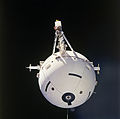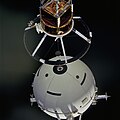STS-46 was a NASA Space Shuttle mission using Atlantis and was launched on July 31, 1992, and landed on August 8, 1992.
Crew
| Position | Astronaut | |
|---|---|---|
| Commander | Third and last spaceflight | |
| Pilot | First spaceflight | |
| Mission Specialist 1 | First spaceflight | |
| Mission Specialist 2 | Second spaceflight | |
| Mission Specialist 3 | Third spaceflight | |
| Mission Specialist 4 | Third spaceflight | |
| Payload Specialist 1 | Only spaceflight | |
Backup crew
| Position | Astronaut | |
|---|---|---|
| Payload Specialist 1 | First spaceflight | |
Crew seating arrangements
| Seat[3] | Launch | Landing |  Seats 1–4 are on the Flight Deck. Seats 5–7 are on the Middeck. |
|---|---|---|---|
| S1 | Shriver | Shriver | |
| S2 | Allen | Allen | |
| S3 | Nicollier | Hoffman | |
| S4 | Ivins | Ivins | |
| S5 | Hoffman | Nicollier | |
| S6 | Chang-Díaz | Chang-Díaz | |
| S7 | Malerba | Malerba |
Mission highlights
The mission's primary objectives were the deployment of the European Space Agency's European Retrievable Carrier (EURECA) and the joint NASA/ASI (Italian Space Agency) Tethered Satellite System (TSS-1). EURECA was deployed a day later than scheduled because of a problem with its data handling system. Seven and a half hours after deployment, the spacecraft's thrusters were fired to boost EURECA to its planned operating altitude of around 500 km (310 mi). However, thruster firing was cut to six minutes from twenty-four minutes because of unexpected attitude data from the spacecraft. The problem was resolved, and EURECA was successfully boosted to its operational orbit on the mission's sixth day. TSS-1 deployment also was delayed one day because of the problems with EURECA. During deployment, the satellite reached a maximum distance of only 260 m (850 ft) from the orbiter instead of the planned 20 km (12 mi) because of a jammed tether line. After numerous attempts over several days to free the tether, TSS-1 operations were curtailed, and the satellite was stowed for return to Earth. It would be reflown in 1996 on STS-75, with astronauts Allen, Hoffman, Nicollier and Chang-Díaz also flying again on that mission.
Secondary payloads included the Evaluation of Oxygen Integration with Materials/Thermal Management Processes (EOIM-III/TEMP 2A), Consortium for Materials Development in Space Complex Autonomous Payload (CONCAP II and CONCAP III), IMAX Cargo Bay Camera (ICBC), Limited Duration Space Environment Candidate Materials Exposure (LDCE), Pituitary Growth Hormone Cell Function (PHCF), and the Ultraviolet Plume Instrument (UVPI). The mission was extended by a day in order to complete scientific objectives.
Gallery
-
EURECA after deployment
-
TSS-1 satellite
-
TSS-1 tether close-up deployment
-
TSS-1 fully extended deployment
See also
- STS-75, a space shuttle mission with objectives similar to those of STS-46
- List of human spaceflights
- List of Space Shuttle missions
- Outline of space science
- Space Shuttle
Notelist
- ^ Robert L. Gibson had originally been selected to command STS-46, however, after he was involved in an air race collision, he was suspended from training for this mission.[2] Gibson would fly again on STS-47.
References
![]() This article incorporates public domain material from websites or documents of the National Aeronautics and Space Administration.
This article incorporates public domain material from websites or documents of the National Aeronautics and Space Administration.
- ^ Ryba, Jeanne (March 31, 2010). "STS-46". NASA. Retrieved February 9, 2022.
- ^ Harwood, William (July 9, 1990). "Two shuttle commanders disciplined, grounded". UPI Archive. Retrieved January 18, 2022.
Gibson also was barred from T-38 jet trainer flights for one year while Walker was grounded for 60 days. Neither pilot will be eligible for reassignment to a shuttle mission until they are back on T-38 flight status.
- ^ "STS-46". Spacefacts. Retrieved March 4, 2014.
External links
- NASA mission summary Archived May 27, 2010, at the Wayback Machine
- STS-46 Post Flight Presentation











Recent Comments